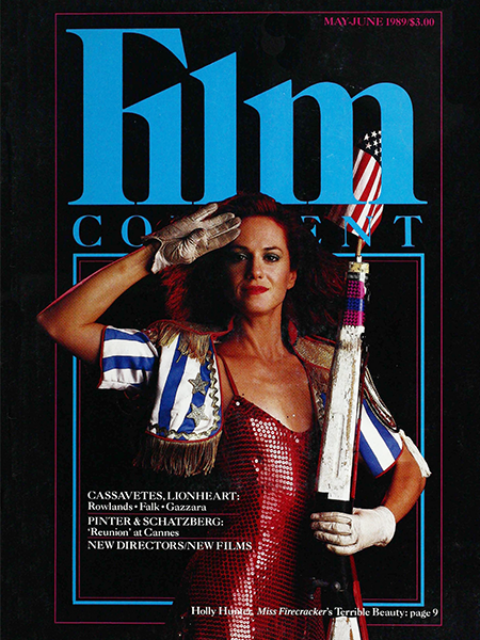
Woman of Influence: Gena
Imagine if you will—just for a moment—Gena without John. Tall, blonde, Nordic-gorgeous Gena from the state of Wisconsin, alone in Hollywood. Allow your mind to play across the performances of other strikingly beautiful and gifted actresses with champagne tresses, especially those who are statuesque, with high cheekbones and remote, shaded eyes. Mostly you see gargoyles, women who represent the nightmare of some director or producer, who symbolize the collective dark side of fair-haired femaleness in American cinema.
But Gena plays women the way women see themselves, slouching towards Bethlehem with schemes and dreams, ducking somebody’s fist, coping with an assortment of “others”—usually men and children—whose proprietary interest is frequently disguised as good intentions. Always multidimensional and complex.
Imagine Gena in movies of the Forties. Wouldn’t she have given Bacall and Lake and Hayworth a run for their money? Sure, she could’ve been the grandest femme fatale of them all. But she was just a child in the Forties and by the time she was ready to roll, the situation for actresses had grown dire: during much of the Sixties and most of the Seventies, when movies were about men and boys, Gena could’ve been sitting on the sidelines, playing bitches and ice queens now and again.
But for John.
He first saw her in a play called Dangerous Corners, went backstage and asked her out. A week later she accepted and four months later they wed. That was 1954. In 1962 they worked together as director and actress for the first time, in A Child is Waiting, and three years later their collaboration began in earnest with Faces. They had two children, Nicholas (1959) and Alexandra (1965) and made five more films together, including perhaps the seminal female performance of the Seventies, A Woman Under the Influence—Gena’s first Academy Award nomination.
Making Faces together was pretty rough, Gena told an interviewer at the time. “The first day you realize your husband doesn’t love you any more, the second day that he never loved you, the third that he hates you…and after that it gets bad.”
But ten years later, after Minnie and Moskowitz, A Woman Under the Influence and Opening Night, she had very different things to say. “To work with John is what you dream of when you just enter the business and your hopes are pure…to be loved by a director who is an actor, who understands your problems…encourages and believes in you to the point where you’re able to push yourself into areas you fear to risk with other directors because of the possible censure involved, because of the embarrassment.”

Minnie and Moskowitz (John Cassavetes, 1971)
They had obviously made artistic peace with each other because two of their most powerful films followed, Gloria (1980) and Love Streams (1983), their last together, plus searing, unforgettable theater work in Los Angeles.
John allowed Gena to transcend her own beauty, to shatter stereotypical notions of the remote blonde. When good women’s roles were almost nonexistent, he wrote them for her, and she in turn transformed his macho boozy poetrics into something about the whole human condition.
In every film they made together, he positioned her to represent the best side of our humanness. Even half-crazy, she takes responsibility, looking after children and animals alike—and sometimes the men, too. Except perhaps for A Woman Under the Influence—depending on interpretation—Cassavetes never cast Rowlands as a victim.
He must’ve been mesmerized by her beauty. And respected it, for he never asked her to forsake it. Her amazing hair floats through his frames, luxuriant. Even though her characters are rarely women of means, she’s always beautifully dressed. In Gloria—her second Oscar nod—she wore Emmanuel Ungaro’s exquisitely tailored silk suits and skyscraper high heels through quasi-tenements. Cassavetes relished her style. In the picture’s pivotal scene, when she starts shooting the gangsters, he pulls his camera back just the right distance so her leggy beauty and Valkyrian strength fills the screen. Almost overwhelming. At moments like that, director-husband-lover merged.

Gloria (John Cassavetes, 1980). Photo by Columbia/Kobal/Shutterstock.
John understood very well that her beauty was also a problem to be dealt with, a source of pain. In Minnie and Moskowitz, a poor sot whom she’s being kind to ask, “What is it with you and blondes, you all have some suicide impulse?” Later, he slaps her around. As her brother in Love Streams, Cassavetes’ character behaves like a compulsively unfaithful lover, bewildered by his complex feelings for her.
He conveyed the ways in which a woman’s beauty and sheer goodness can make a man feel vulnerable and afraid, possibly inadequate. Sometimes this got translated as hostility and depersonalized ridicule. Cassavetes’ men were capable of grasping at almost anything to deny a woman’s power over them.
It is of course true that Gena always looked a little out of place in those films, altogether too classy. Yet we accepted her. The strength of their mutual artistry created a convincing poetic reality.
The majesty of Gena Rowlands honors a unique and courageous filmmaker who has left an unfillable void. Though their collaboration is no more, she is a fully-evolved artist in her own right.
She once said, “At a certain point in your life, you can no longer depend upon the things that upheld you in your youth; you must accept your second self and embrace it.” As part of an enduring legacy from John Cassavetes, we look forward to Gena’s second artistic self, even as we grieve for her—and our—loss.








